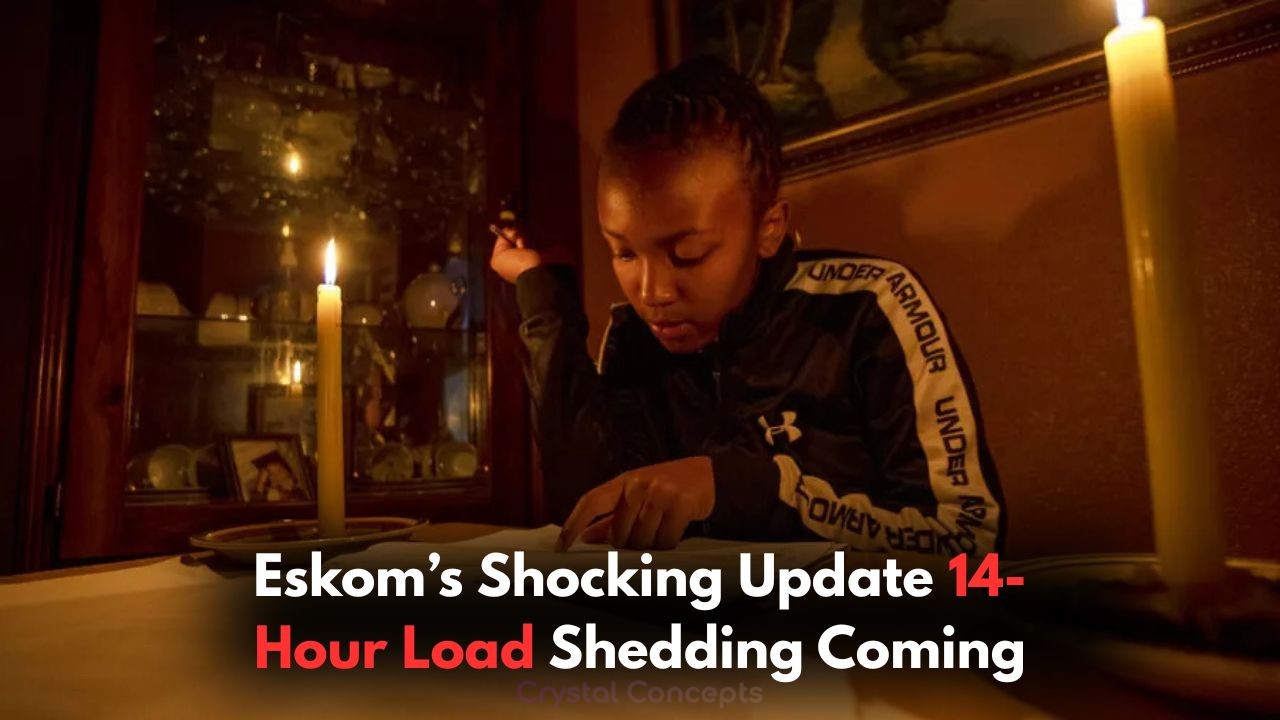South Africa is once again facing a major power crisis as Eskom has confirmed a nationwide 14-hour blackout schedule rolling out this week. With load shedding returning aggressively due to severe strain on the grid, millions of households across provinces such as Gauteng, KwaZulu-Natal, and the Western Cape will experience extended power cuts. Eskom has cited a sharp rise in electricity demand, maintenance backlogs, and low reserve generation capacity as the key reasons behind this week’s extended load shedding cycle. The latest schedule is expected to severely disrupt businesses, schooling, and daily household routines. In this article, we break down the full list of impacted areas, timing blocks, Eskom’s official statements, tips to prepare, and the expected duration of Stage 4 and Stage 6 cuts.
Why Eskom Has Announced 14-Hour Load Shedding This Week
The announcement comes in the wake of growing instability in Eskom’s generation fleet, worsened by cold weather and heightened winter energy consumption. The utility has acknowledged critical shortages and emergency repairs at multiple key power stations.
Key reasons behind this intensified load shedding:
- Generation loss due to breakdowns at key power stations like Medupi and Kusile
- Incomplete maintenance cycles for several units
- Increased winter electricity demand across households
- Low levels of emergency reserves including diesel and pumped storage
- Risk of total grid instability without longer shedding blocks
As per Eskom, this measure is aimed at preventing a nationwide blackout by balancing supply and demand in real-time.
Full Load Shedding Schedule: Area-Wise Power Outage Blocks
Eskom has released a detailed province-wise blackout schedule valid from Monday, 10 July to Saturday, 15 July 2025. Below is a sample of the affected zones and their expected outage hours. Please refer to EskomSePush or the official municipal websites for real-time updates.
Gauteng Region – Johannesburg and Surroundings
| Date | Stage | Time Block 1 | Time Block 2 | Time Block 3 | Total Hours |
|---|---|---|---|---|---|
| 10 July | 4 | 06:00 – 10:30 | 14:00 – 17:30 | 20:00 – 22:00 | 8.5 hrs |
| 11 July | 6 | 04:00 – 08:30 | 12:00 – 15:30 | 18:00 – 22:00 | 10.5 hrs |
| 12 July | 6 | 05:00 – 09:30 | 13:00 – 17:30 | 19:00 – 23:00 | 11 hrs |
| 13 July | 4 | 06:00 – 10:00 | 14:00 – 17:00 | 20:00 – 22:00 | 8 hrs |
| 14 July | 6 | 04:00 – 08:30 | 12:00 – 15:30 | 18:00 – 22:00 | 10.5 hrs |
| 15 July | 4 | 06:00 – 10:00 | 14:00 – 17:00 | 20:00 – 22:00 | 8 hrs |
Western Cape – Cape Town and Nearby Municipalities
| Date | Stage | Morning Cut | Afternoon Cut | Evening Cut | Total Hours |
|---|---|---|---|---|---|
| 10 July | 4 | 07:00 – 09:30 | 13:00 – 16:00 | 20:30 – 23:30 | 8.5 hrs |
| 11 July | 6 | 05:00 – 08:00 | 12:00 – 15:00 | 19:00 – 22:30 | 10.5 hrs |
| 12 July | 6 | 04:30 – 08:00 | 11:30 – 14:30 | 18:00 – 22:00 | 10 hrs |
| 13 July | 4 | 06:00 – 09:00 | 14:00 – 17:00 | 20:00 – 22:30 | 8.5 hrs |
What Eskom and Government Officials Have Said
Eskom’s interim spokesperson, Daphne Mokwena, explained during a recent briefing:
“Due to the unavailability of more than 18,000MW from our generation fleet, we are forced to implement Stage 6 load shedding to prevent grid collapse. Our engineers are working around the clock, but critical maintenance backlogs remain.”
Additionally, the Ministry of Public Enterprises issued a statement acknowledging the crisis and promising intervention through faster procurement of diesel reserves and alternative energy supplies.
Areas Most Heavily Affected
Some of the regions expected to experience the longest blackouts this week include:
- Gauteng: Soweto, Midrand, Centurion
- KwaZulu-Natal: Durban Central, Umlazi, Phoenix
- Western Cape: Cape Town Southern Suburbs, Stellenbosch
- Eastern Cape: Port Elizabeth, Mthatha, East London
- Free State: Bloemfontein, Welkom
Residents in rural and township areas are particularly vulnerable due to longer resumption delays after cuts.
What Stage 6 Load Shedding Means for You
Under Stage 6 load shedding:
- Households face 3–4 blackouts per day, each lasting 2 to 4 hours
- Power supply can be cut without prior notice in emergencies
- Mobile networks, ATMs, and traffic lights may not function
- Refrigeration cycles for food and medicine storage are disrupted
- Backup power sources like inverters and generators face overuse
Load shedding at this intensity significantly impacts small businesses, students, and the healthcare sector.
Practical Tips to Prepare for the Blackouts
Make your household load-shedding-ready with the following:
- Keep phone power banks charged at all times
- Freeze large bottles of water to keep fridges cold during blackouts
- Use gas stoves or solar cookers for meal prep
- Install backup UPS for routers and alarm systems
- Write down emergency numbers and offline addresses
Also, try to plan major tasks and errands around the scheduled blackout blocks to minimize disruptions.
Impact on Daily Life and Businesses
Power cuts at this scale lead to loss of productivity, financial strain, and increased mental stress. Sectors affected the most include:
- Retail and food: Stock spoilage and customer drop-off
- Education: Online learning and digital classes interrupted
- Healthcare: Clinics and pharmacies lose refrigeration
- Transport: Traffic chaos due to inactive signals
Several NGOs have called on the government to declare an energy emergency and allocate funds for local backup systems in underserved areas.
When Will the Situation Improve?
According to Eskom’s update, limited relief may come by the end of July, if repairs at four major power plants are completed on schedule. However, if cold weather persists and diesel stocks remain low, Stage 6 could continue until August.
Eskom is also banking on the Independent Power Producer Procurement Programme (IPPPP) to ramp up renewable integration in late 2025, but immediate relief remains uncertain.
The return of 14-hour load shedding is a serious signal of South Africa’s deepening energy crisis. With Eskom struggling to meet the demand, and infrastructure lagging behind, South Africans must brace for difficult weeks ahead. Staying informed, prepared, and energy-conscious can help communities navigate this challenging period.
Frequently Asked Questions (FAQs)
Q1: What is Stage 6 load shedding?
A: Stage 6 means Eskom removes up to 6000MW from the national grid, resulting in up to 12–14 hours of blackouts per area daily.
Q2: Where can I check my local blackout schedule?
A: Use the EskomSePush app or visit your municipal electricity portal to get real-time updates.
Q3: Can load shedding affect water supply?
A: Yes, in some areas water pumps rely on electricity. Prolonged blackouts may reduce water pressure or stop supply temporarily.
Q4: Are schools and hospitals exempt from blackouts?
A: Not all. While some essential services have partial exemptions, many still face cuts. Backup generators are used in most hospitals.
Q5: How long will Stage 6 last?
A: Eskom estimates at least one week, but this can be extended depending on power station repairs and energy demand levels.








